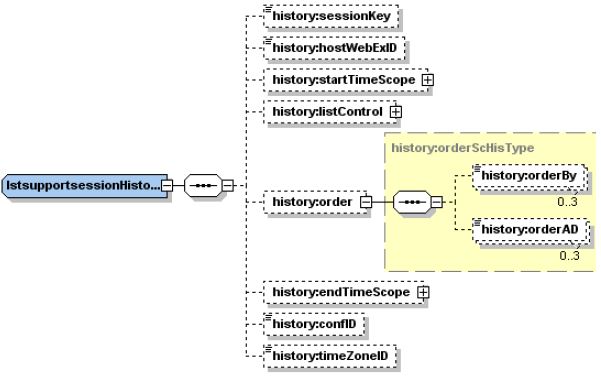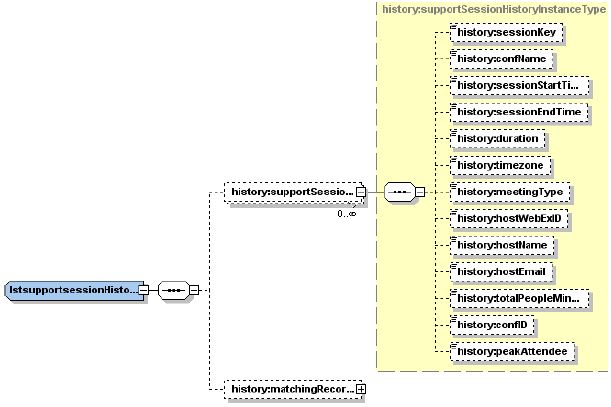LstsupportsessionHistory
Allows support session hosts or site administrators to request detailed
usage data for previously hosted support sessions.
Note A host can only access his or her own support session history,
but a site administrator can access the history of all the support
sessions hosted on his or her site. When a site administrator specifies
a hostWebExID, the system will return the data of the specified host's
support sessions; if a hostWebExID is not specified, all the support
sessions on his or her site will be returned. If you are not a site
administrator, the element hostWebExID will be ignored.
Request
The following schema diagram shows the structure of the elements in thelstsupportsessionHistory request message.
Figure 9-19 • Schema diagram for lstsupportsessionHistory
The sample XML document queries for the support session history on the site for the specified period of time.
<?xml version="1.0" encoding="UTF-8"?>
<serv:message xmlns:xsi="http://www.w3.org/2001/XMLSchema-instance">
<header>
<securityContext>
<webExID>hostid</webExID>
<password>hostpassword</password>
<siteID>0000</siteID>
<partnerID>9999</partnerID>
<email>johnsmith@xyz.com</email>
</securityContext>
</header>
<body>
<bodyContent xsi:type=
"java:com.webex.service.binding.history.LstsupportsessionHistory">
<startTimeScope>
<sessionStartTimeStart>03/28/2004 03:04:03
</sessionStartTimeStart>
<sessionStartTimeEnd>03/31/2004 03:04:03</sessionStartTimeEnd>
</startTimeScope>
<endTimeScope>
<sessionEndTimeStart>03/28/2004 03:04:03</sessionEndTimeStart>
<sessionEndTimeEnd>03/31/2004 03:04:03</sessionEndTimeEnd>
</endTimeScope>
<listControl>
<serv:startFrom>1</serv:startFrom>
<serv:maximumNum>10</serv:maximumNum>
<serv:listMethod>AND</serv:listMethod>
</listControl>
<order>
<orderBy>CONFNAME</orderBy>
<orderAD>ASC</orderAD>
</order>
</bodyContent>
</body>
</serv:message>
For descriptions of the global elements in the security context of the
header, please see Global Request Elements in Security Context.
For descriptions of the non-global elements, please refer to “Elements
in WebEx XML Schema Definitions for the History Service”.
Response
Note The expanded diagram for history:matchingRecords{name="font"
face="Georgia, Times New Roman, Times, serif"} can be found in Figure
G-51.
The following schema diagram shows the structure of the elements in thelstsupportsessionHistoryResponse message.
Figure 9-20 • Schema diagram for lstsupportsessionHistoryResponse
The sample XML document shows an example of a possible response to the preceding request document.
<?xml version="1.0" encoding="UTF-8"?>
<serv:message xmlns:serv="http://www.webex.com/schemas/2002/06/service"
xmlns:com="http://www.webex.com/schemas/2002/06/common"
xmlns:history="http://www.webex.com/schemas/2002/06/service/history">
<serv:header>
<serv:response>
<serv:result>SUCCESS</serv:result>
<serv:gsbStatus>PRIMARY</serv:gsbStatus>
</serv:response>
</serv:header>
<serv:body>
<serv:bodyContent xsi:type="history:LstsupportsessionHistoryResponse"
xmlns:xsi="http://www.w3.org/2001/XMLSchema-instance">
<history:supportSessionHistory>
<history:sessionKey>15375492</history:sessionKey>
<history:confName>test join states 01</history:confName>
<history:sessionStartTime>03/29/2004 02:04:03
</history:sessionStartTime>
<history:sessionEndTime>03/29/2004 02:19:09
</history:sessionEndTime>
<history:duration>16</history:duration>
<history:timezone>4</history:timezone>
<history:meetingType>SC3</history:meetingType>
<history:hostWebExID>java</history:hostWebExID>
<history:hostName>java</history:hostName>
<history:hostEmail>java@sz.com</history:hostEmail>
<history:totalPeopleMinutes>19</history:totalPeopleMinutes>
<history:confID>4702314</history:confID>
<history:peakAttendee>1</history:peakAttendee>
</history:supportSessionHistory>
<history:matchingRecords>
<serv:total>1</serv:total>
<serv:returned>1</serv:returned>
<serv:startFrom>1</serv:startFrom>
</history:matchingRecords>
</serv:bodyContent>
</serv:body>
</serv:message>
The result and exceptionID global elements allow you to confirm that
an instantiation request was successful. They are described in "Global Response
Elements Showing Results and Errors”.

